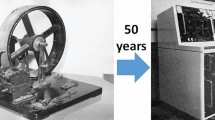Abstract
Electroanalytical methods are often seen as an effective tool to study chemical and biological systems. This chapter gives an overview of the most common electrochemical sensing techniques, their basic working principles and their typical configurations, paying a brief look to some more recent developments. Due to the huge extension of the subject and to the very large amount of the possible applications, what is given here is a synthesized review of the most general families of methods regarding aqueous solutions, together with a few particular application examples. In the most recent developments, the combination of electroanalytical techniques with different sensing methods, and the usage of signal processing techniques for pattern recognition applied to the electroanalytical data series, emerged in the scientific literature, as pointed out in the text.
Access this chapter
Tax calculation will be finalised at checkout
Purchases are for personal use only
Preview
Unable to display preview. Download preview PDF.
Similar content being viewed by others
References
Alfonta L., Bardea A., Khersonsky O., Katz E. and Willner I., 2001, Chronopotentiometry and Faradaic impedance spectroscopy as signal transduction methods for the bio-catalytic precipitation of an insoluble product on electrode supports: routes for enzyme sensors, immunosensors and DNA sensors, Biosensors & Bioelectronics, 16: 675-687.
Baldock S. J., Fielden P. R., Goddard N.J., Prest J. E. and Treves Brown B. J., 2003, I ntegrated moulded polymer electrodes for performing conductivity detection on isotachophoresis microdevices, Journal of Chromatography A, 990:11-22.
Bard A. J. and Faulkner L. R., 1980 (1st ed.), 2000 (2nd ed.), Electrochemical methods, fun-damentals and applications, John Wiley & Sons.
Bates R.G., 1973, Determination of pH, Wiley-Interscience.
Bond A.M., 1980, Modern polarography methods in analytical chemistry, CRC Press. Butler A.V., 1926, Proc. Royal Society, London, 112A, 129 pp.
Ciosek P., Brzózka Z. and Wróblewski W., 2004, Classification of beverages using a re-duced sensor array, Sensors and Actuators B, 103:76-83.
Delahay P. and Reilley C.N., 1954, New instrumental methods in electrochemistry, Wiley-Interscience.
Freiser H. (Ed.), 1978, Ion-Selective Electrodes in Analytical Chemistry, Plenum.
Garrels R.M., 1967, Glass Electrodes for Hydrogen and Other Cations, George Eiseman (Ed.), Marcel Decker.
Guggenheim E.A., 1929, J. Phys. Chem., 33, 842 pp.
Guggenheim E.A., 1930, J. Phys. Chem., 34, 1540 pp.
Ives D.J.G. and Janz G.J. 1961, Reference Electrodes, Theory and Practice. Academic Press. Iwamoto Y., 1993, Conductivity meter and method of producing an electrode for use in same, US patent US5212018.
Janata J., 1989, Principles of chemical sensors, Plenum.
Krantz-Rulcker C., Stenberg M., Winquist F. and Lundstrom I., 2001, Electronic tongues for environmental monitoring based on sensor arrays and pattern recognition: a review, Analytica chimica acta, 426: 217-226.
Legin A., Rudnitskaya A., Vlasov Y., Di Natale C., Mazzone E. and D’Amico A., 1999, Application of Electronic Tongue for Quantitative Analysis of Mineral Water and Wine, Electroanalysis, No. 10-11.
Luce R. S., 1986, Instrument for measuring electrical conductivity of a liquid, US patent US4585996.
Lvova L., Kima S.S., Legin A., Vlasov Y., Yang J.S., Chaa G.S. and Nama H., 2002, All-solid-state electronic tongue and its application for beverage analysis, Analytica Chimica Acta, 303-314.
Macdonald D.D., 1977, Transient Techniques in. Electrochemistry, Plenum Press.
Mishuk V. Ya., Elkin V.V., Abaturov M.A., Alekseev V.N. and Grafov B.M., 2002, Second-order Impedance in Electrode Kinetics, Russian Journal of Electrochemistry, 38(9): 959-964. Translated from Elektrokhimiya, 38(9): 1069-1074.
Robertsson L. and Wide P., 2005, Improving food quality analysis using a wavelet method for feature extraction, IEEE IMTC, Ottawa (CA), 1: 93-97.
Rodríguez-Méndez M.L., Arrieta A.A., Parra V., Bernal A., Vegas A., Villanueva S., Gutiérrez-Osuna R. and De Saja J. A., 2004, Fusion of Three Sensory Modalities for the Multimodal Characterization of Red Wines, IEEE Sensors Journal, 4(3).
Saum A.G.E., Cumming R.H. and Rowell F.J., 1998, Use of substrate coated electrodes and AC impedance spectroscopy for the detection of enzyme activity, Biosensors & Bio-electronics, 13: 511-518.
Scozzari A., Acito N. and Corsini G., 2005, Signal analysis of voltammetric data series for water quality tests and classification, IEEE IMTC, Ottawa (CA), 1: 89-92.
Scozzari A., Acito N. and Corsini G., 2007, A novel method based on voltammetry for the qualitative analysis of water, IEEE Transactions on Instrumentation and Measurement, 56 (6).
Scozzari A., 2007. Application of an e-tongue to groundwater monitoring: a measurement perspective, 12th Symposium on Water-Rock Interaction, Bullen & Wang (eds), Taylor & Francis group, Kunming (Cina), 2: 1115-1118.
Yang L., 2008, Electrical impedance spectroscopy for detection of bacterial cells in sus-pensions using interdigitated microelectrodes, Talanta, 74: 1621-1629.
Winquist F., Wide P. and Lundstrom I., 1997, An electronic tongue based on voltammetry, Analytica chimica acta, 357: 21-31.
Winquist F., Lundstrom I. and Wide P., 1999, The combination of an electronic tongue and an electronic nose, Sensors and Actuators B 58, 512-517.
Author information
Authors and Affiliations
Corresponding author
Editor information
Editors and Affiliations
Rights and permissions
Copyright information
© 2008 Springer Science + Business Media B.V.
About this paper
Cite this paper
Scozzari, A. (2008). Electrochemical Sensing Methods: A Brief Review. In: Evangelista, V., Barsanti, L., Frassanito, A.M., Passarelli, V., Gualtieri, P. (eds) Algal Toxins: Nature, Occurrence, Effect and Detection. NATO Science for Peace and Security Series A: Chemistry and Biology. Springer, Dordrecht. https://doi.org/10.1007/978-1-4020-8480-5_16
Download citation
DOI: https://doi.org/10.1007/978-1-4020-8480-5_16
Publisher Name: Springer, Dordrecht
Print ISBN: 978-1-4020-8479-9
Online ISBN: 978-1-4020-8480-5
eBook Packages: Biomedical and Life SciencesBiomedical and Life Sciences (R0)




